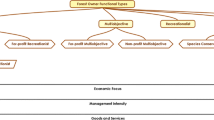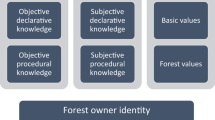Abstract
This paper investigates forest ownership objectives and the need for information among Estonian and Finnish private forest owners based on two surveys. The motivation for the analysis is the fragmenting private forest ownership in Europe. The broad lines of ownership objectives are found to be similar in both countries, and can be described under the dimensions of economic objectives, intangible values, and products and activities provided by forests. In both countries, economic and intangible objectives are considered important at the same time. Thus forest owners can be described as multi-objective. The economic objectives are ranked as somewhat more important than non-economic objectives in Estonia, but not in Finland. Estonian forest owners most strongly emphasise information about legal and economic matters, including forest taxation and forest health issues, while Finnish forest owners emphasise information about wood markets and forest taxation. Differences between the two countries may be related to private ownership being relatively new in Estonia. Some generalisations may be drawn for European forest policy. Overall, private forest owners need both information about economic issues and personal advice on how to manage forests with regard to their individual and multiple objectives. Generally, personal advice may be concentrated on the complicated and most important themes, while information can mostly be provided via written or electronic channels. Particularly in countries where private forestry is new, there is a need for personal advice on legislative and economic matters. As a conclusion, it is suggested that efficient allocation of resources and development of information services require regular analysis of private forest ownership, and segmenting private forest owners according to their objectives and information needs.
Similar content being viewed by others
References
Afifi, A.A. and Clark, W. (1990), Computer-aided Multivariate Analysis, 2nd edn, Lifetime Learning Publications, Van Nostrand Reinhold, Belmond.
Blum, A. and Schanz, H. (2002), ‘From input-oriented subsidy schemes and beyond — theoretical implications of subsidy systems in forestry’, in A. Ottitsch, I. Tikkanen and P. Riera (eds), Financial Instruments of Forest Policy, FEI Proceedings, No. 42, Gummerus Printing, Saarijärvi.
Boyd, R. (1984), ‘Government support of nonindustrial production: The case of private forests’, Southern Journal of Economics, 5: 89–107.
Brazee, J.R. (2003), ‘The Volvo Theorem: From myth to behaviour model’, in F. Helles, N. Strange and L. Wichman (eds), Recent Accomplishments in Applied Forest Economics Research, Dordrecht, Forestry Sciences, 74: 39–48, Kluwer Academic Publishers.
Carlén, O. (1990), ‘Private Nonindustrial Forest Owners’ Management Behaviour. An Economic Analysis Based on Empirical Data’, Rapport 92, Institutionen för Skogsekonomi, Sveriges Lantbruksuniversitet, Umea, Sweden.
Cleaves, D.A. and Bennett, M. (1994), ‘Holding size and behavior of nonindustrial private landowners: A cautious second look’, in D.H. Newman and M.E. Aronow (eds), Forest Economics on the Edge, US Department of Agriculture, Forest Service, Southern Forest Experiment Station, New Orleans, Louisiana.
Centre of Forest Protection and Silviculture (2001a), Estonian Forestry Development Programme, Draft 2.3, www.metsad.ee, last accessed 10 August 2001, (In Estonian).
Centre of Forest Protection and Silviculture and Ministry of the Environment of Estonia (2001b), ‘The need for advising and the strategy for extension services in forestry’, Metsandusliku nõuande vajaduse analüüs ja metsandusliku nõuande strateegia väljätöötamine, Final Report, Tartu, (In Estonian).
Dennis, D.F. (1989), ‘An economic analysis of harvest behavior: integrating forest and ownership characteristics’, Forest Science, 35(4): 1088–1104.
ECOSOC (European Economic and Social Committee) (2002), Opinion on the Eastward Enlargement of the European Union and the Forestry Sector, CES 523/2002, ISSN 1015–9487, Luxembourg.
FAO (2002), UNECE/FAO FORESTRY database (2002), http://apps.fao.org/page/ collections? subset=forestry, last accessed March 2002.
Finnish Forest Research Institute (2004), Finnish Statistical Yearbook of Forestry, Agriculture, Forestry and Fishery, Vammalan Kirjapaino Oy, Vammala.
EU (European Union) (1998), Forestry Strategy of the European Union, Communication from the Commission 1998, COM(1998)649.
Grayson, A.J. (1993), Private Forestry Policy in Western Europe, Scottish Forestry Trust, UK, Short Run Press Ltd, Essex.
Greene, J.L. and Blatner, K.A. (1986), ‘Identifying woodland owner characteristics associated with timber management’, Forest Science, 32(1): 135–146.
Hair, J.R., Anderson, R.E., Tatham, R.L. and Black, W.C. (1995), Multivariate Data Analysis with Readings, 4th edn, Prentice Hall, Englewood Cliffs, New Jersey.
Hänninen, H. and Viitala, E.J. (1994), ‘Metsänomistuksen rakennemuutos ja metsien käyttö, (Chang e in forest ownership structure and use of forests)’, in Ovaskainen and Kuuluvainen (eds) 1994, Yksityismetsänomistuksen rakennemuutos ja metsien käyttö (Structural change in private forestry and the use of forests), The Finnish Forest Research Institute, Research Notes 484, Gummerus kirjapaino Oy, Jyväskylä, (In Finnish with English abstract).
Hänninen, H. and Uusipuro, J. (2002), ‘Metsänomistajat neuvonnan ja metsäsuunnittelun käyttäjinä (Forest owners as users of forest management planning and extension)’, Työtehoseuran metsätiedote 651 (Finnish Work Efficiency Association Forest Note 651), (In Finnish).
Hänninen, H., Karppinen, H., Ovaskainen, V. and Ripatti, P. (2001), ‘Metsänomistajan uudistamiskäyttäytyminen (Forest owners’ reforestation behaviour)’, Metsätieteen aikakauskirja 4(2001): 615–629, (In Finnish).
Hyttinen, P. (2000), ‘Policy aspects of small-scale forestry in Europe’, in S.R. Harrison, J.L. Herbohn and K.F. Herbohn (eds), Sustainable Small-Scale Forestry, Socio-economic Analysis and Policy, University Press, Cambridge.
Hyttinen, P. (2004), ‘Small-scale forestry: Perspectives around the world’, in Encyclopedia of Forest Sciences, Elsevier Ltd.
Ihalainen, R. (1990), ‘Rakennemuutokset yksityismetsänomistuksessa. Katsaus Suomessa 1960–89 tehtyihin tutkimuksiin, (Structural changes in Finnish non-industrial private forest ownership: A survey of the literature 1960–89)’, Folia Forestalia 750, Finnish Forest Research Institute, (In Finnish with English summary).
Järvinen, E., Toivonen, R. and Kaimre, P. (2003), The Information and Training Needs of Private Forest Owners in Estonia, PTT Working Papers 61 (January 2003), Helsinki.
Järveläinen, V-P. and Torvelainen, J. (1993), ‘Yhteiskunnan muutoksen vaikutus metsä- ja puutalouden tarjontatekijöihin, Summary: Impact of Social Change on Supply Factors in Finnish Forestry and the Forest Industry’, Department of Economics and Management, University of Helsinki, Publications No. 2, Private Forestry, Helsinki, (In Finnish with English Summary).
Karppinen, H. (1996), Private forestry in Estonia - results from a survey study conducted together with Indufor Oy, Estonian Forestry Development Program (EFDP) Technical Report 4, June 1996, Tallinn.
Karppinen, H. (2000), ‘Forest Values and the Objectives of Forest Ownership, Metsäntutkimuslaitoksen tiedonantoja 757’, The Finnish Forest Research Institute, Research Papers 757, Helsinki.
Karppinen, H., Hänninen, H. and Ripatti, P. (2000), ‘Changes in the Structure of Finnish Private Forest Ownership in the 1990s’, in L. Hetemäki (ed.), Finnish forest sector economic outlook 2000–2001, The Finnish Forest Research Institute, Vantaa.
Karppinen, H., Hänninen, H. and Ripatti, P. (2002), ‘Suomalainen metsänomistaja 2000 (Finnish forest owner 2000)’, Finnish Forest Research Institute, Research Papers 852, Vantaa Research Centre, Gummerus Oy Jyväskylä, (In Finnish).
Kuuluvainen, J., Karppinen, H. and Ovaskainen, V. (1996), ‘Testing the forest rotation model: Evidence from Panel data’, Forest Science, 45: 539–551.
Kuuluvainen, J. and Ovaskainen, V. (1994), ‘Yksityismetsän omistajien puunmyynteihin vaikuttavat tekijät’ (Factors affecting wood sales from private forests)’, in V. Ovaskainen and J. Kuuluvainen (eds), Yksityismetsänomistuksen rakennenuutos ja metsien käyttö (Structural change in private forestry and the use of forests), The Finnish Forest Research Institute, Research Notes 484, Gummerus kirjapaino Oy, Jyväskylä, (In Finnish with English abstract).
Kuuluvainen, J., Ovaskainen, V., Karppinen, H. and Hänninen, H. (1995), ‘Omistusrakenteen muutos ei uhkaa puuhuoltoa (Changing forest ownership structure is not challenging wood supply)’, Paper and Timber, 4: 158–160, (In Finnish).
Leppänen, J., Pajuoja, H. and Toppinen, A. (2001), ‘Effects of public support for forestry on timber supply’, in B. Solberg, (ed.), Scandinavian Forest Economics, 37: 257–267.
Linden, M. and Leppänen, J. (2003), ‘The impact of government investment assistance on forest investment and timber supply’, in F. Helles, N. Strange and L. Wichman (eds), Recent Accomplishments in Applied Forest Economics Research, Forestry Sciences, 74, 167–179, Kluwer Academic Publishers, Dordrecht.
Lindroos, K. (2005), ‘Metsänomistajien tavoitteet sekä tieto- ja neuvontatarpeet (Forest owners’ objectives and information and training needs)’, PTT Working Papers, No 76, Helsinki, (In Finnish with English abstract).
Marty, T.D., Kurtz, W.B. and Gramann, J.H. (1988), ‘PNIF owner attitudes in the Mid-West. A case study in Missouri and Wisconsin’, Northern Journal of Applied Forestry, 5(3): 194–197.
Mutanen, A. and Toppinen, A. (2004), ‘Finnish sawlog market under forest taxation reform’, Silva Fennica, 39(1): 1–14.
Ottitsch, A., Tikkanen, I. and Riera, P. (eds) (2002), ‘Financial instruments of forest policy’, EFI Proceedings No 42, Gummerus Printing, Saarijärvi.
Ovaskainen, V. and Kuuluvainen, J. (eds.) (1994), Yksityismetsänomistuksen rakennemuutos ja metsien käyttö (Structural change in private forestry and the use of forests), The Finnish Forest Research Institute, Research Notes 484, Gummerus kirjapaino Oy, Jyväskylä, (In Finnish with English abstract).
Ripatti, P. (1996), ‘Factors affecting partitioning of private forest holdings in Finland. A logit analysis’, Acta Forestalia Fennica, 252: 1–84.
Ripatti, P. (1999), ‘One Finnish family in six owns forest’, in A. Reunala, I. Tikkanen and E. Åsvik (eds), The Green Kingdom — Finland’s Forest Cluster, Otava Publishing Ltd, Metsämi esten Säätiö Foundation.
Rämö, A-K., Tilli, T., Lindroos, K., Ruohola, H. and Ripatti, P. (2005), ‘Metsäverojärjestelmän muutos ja yksityismetsänomistajien puun myyntiaikeet vuosina 2004–2007 (Forest taxation reform and forest owners’ roundwood supply during the years 2004 to 2007)’, PTT Reports No. 191, Helsinki, (In Finnish with an English summary).
Schraml. U. and Volz, K.-R. (eds) (2003), ‘Urbane Waldbesitzer (Urban forest owners)’, Freiburger Schriften zur Forst- und Umweltpolitik, Band I, Verlag Dr. Kessel, Remag en-Oberwinter, (In German).
Solberg, B. (2003), Ripatti, P. (1996), ‘Factors affecting partitioning of private forest holdings in Finland. A logit analysis’, Acta Forestalia Fennica, 252: 1–84, Policy developments affecting demand, supply and international trade of forest products: a European perspective’, in L. Teeter et al. (eds), Forest Policy for Private Forestry, Global and Regional Challenges, CABI Publishing, UK.
Statisties Estonia /Statistical Office of Estonia (2001), Database of Statistics, www.stat.ee, last accessed 5 September 2001.
Teeter, L., Cashore, B. and Zhang, D. (eds) (2003), Forest Policy for Private Forestry. Global and Regional Challenges, CABI Publishing, UK.
Tilli, T. and Skutin, S-G. (2004), ‘Roundwood Markets in the Baltic Sea Region’, Pellervo Economic Research Institute, Report No. 188, Helsinki.
Toivonen, R. and Mäki. P. (1999), ‘Eastern Enlargement of European Union and forestry’, PTT Working Papers No. 20, (May 1999), Helsinki, (In Finnish with English abstract).
Toppinen, A., Viitanen, J. and Toivonen, R. (2005), ‘Dynamics of roundwood prices in Estonia, Finland and Lithuania’, Baltic Forestry, 11(1): 88–96.
Ziegenspeck, S. (2002) ‘Challenges for scientific working schemes in Germany concerning the evaluation of subsidies in forestry’, in A. Ottitsch et al. (eds), Financial Instruments of Forest Policy, EFI Proceedings No 42, Gummerus Printing, Saarijärvi.
Author information
Authors and Affiliations
Rights and permissions
About this article
Cite this article
Toivonen, R., Järvinen, E., Lindroos, K. et al. The challenge of information service development for private forest owners: The Estonia and Finland cases. Small-scale Forestry 4, 451–469 (2005). https://doi.org/10.1007/s11842-005-0028-3
Issue Date:
DOI: https://doi.org/10.1007/s11842-005-0028-3




